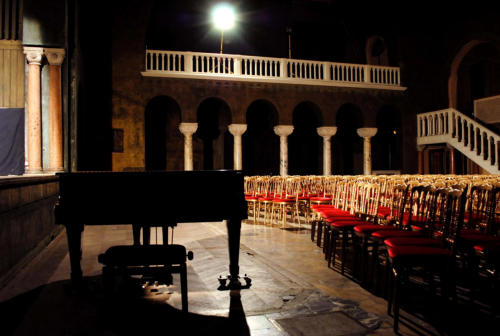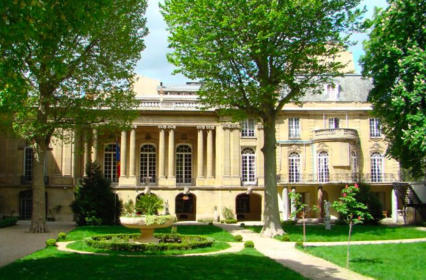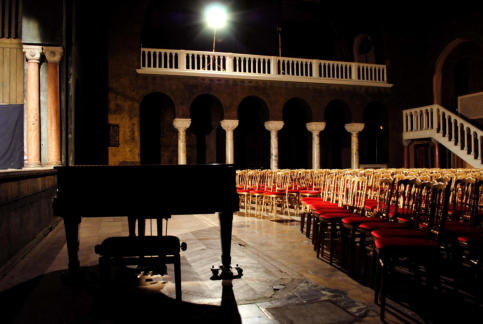


ORGANS OF PARIS © 2024 Vincent Hildebrandt HOME ALL ORGANS


The Palais de Béhague was built at the end of the
19th century for the Countess Martine de Béhague. It
is now the property of Romania, which has set up its
Embassy in Paris there since 1939. It has been listed
in its entirety in the Supplementary Inventory of
Historic Monuments since 1992. It is designed in the
spirit of the great aristocratic hotels of the late
nineteenth century and in the style of the French
eighteenth century.
At the heart of this classical imitation architecture,
from 1898 onwards, a theatre was built and enlarged
at the beginning of the twentieth century. This
theatre, called the Byzantine Hall, because of its
decoration inspired by the Byzantine style, has a rich
history and offers exceptional possibilities.
The architect of the Byzantine Hall was Gustave
Adolphe Gerhardt. Born in Strasbourg in 1843, he
studied at the Ecole des Beaux-Arts and won the
Grand Prix de Rome in 1866 at the age of 23. When
he began the construction of the Byzantine Hall, he
already had to his credit several mansions and the
charge of civil buildings (Collège de France,
Conservatoire National des Arts et Métiers).
Source

C1
Created by Charles Mutin for Martine de Béhague, Countess
of Béarn, the organ of the Palais de Béhague is located in the
large theatre and concert hall, the Salle Byzantine. It is located
on the right side of the stage, at the floor level of the hall.
Thus, because of its location, which is that of a theatre hall
and not that of a church, this organ bears witness to a form of
musical representation that was relatively rare at the very
beginning of the twentieth century, opening up new horizons
in terms of interpretation (concert music, repertoire with
orchestra, plays, etc.).
But the specificity of this instrument lies above all in its
architecture. Hidden from view, enclosed on all sides, the
organ of the Palais de Béhague is perceived as an "expressive
instrument". For example, the lattices of the expressive box
are controlled from the console. They open on four levels on
two sides, one facing the auditorium, the other the stage, so
that the pipes are not visible from the outside. The
instrument's console no longer exists, but the analysis of the
instrumental part allows us to recognize two manual manuals
of 56 notes, a pedalboard of 32 notes and 26 stop gauges, 9
of which are controlled by reed calls: 4 on the Grand Orgue, 4
on the Positif and one on the pedal.
This organ has a remarkable peculiarity. Located under the
organ, at the level and next to the orchestra pit, the wind
tunnel is set in motion thanks to a hydraulic system that was
supplied by the city's water network. The transmission is
mechanical, assisted by Barker machines, and the piping
remains in good condition overall.
The serial numbers on the organ's pipes (378-400 for the
Great Organ and the Pedal, 965-968 for the Récit) testify to
the existence of two different periods. In fact, in 1903 a fire
that took place at the Palais de Béhague damaged the
Byzantine Room. This incident suggests that the two organs
built by Charles Mutin for the Byzantine Hall (attested by the
"List of organs built by the Maison Cavaillé-Coll", published in
1983, without the date or other details of their construction
being specified) were later combined into a single instrument.
Another specific element of this organ is the fact that, having
not been used for more than 60 years, it remains preserved in
its original state, having never been retouched by any other
builder. All these elements contribute to the great historical
interest of this instrument. On June 7, 2007, Charles Mutin's
organ, installed in the Byzantine Hall, was classified as a
Historic Monument.
Source: Marina Tchebourkina


Organs of Paris
ORGANS OF PARIS © 2024 Vincent Hildebrandt ALL ORGANS
C1
Created by Charles Mutin for Martine de Béhague, Countess
of Béarn, the organ of the Palais de Béhague is located in the
large theatre and concert hall, the Salle Byzantine. It is located
on the right side of the stage, at the floor level of the hall.
Thus, because of its location, which is that of a theatre hall
and not that of a church, this organ bears witness to a form of
musical representation that was relatively rare at the very
beginning of the twentieth century, opening up new horizons
in terms of interpretation (concert music, repertoire with
orchestra, plays, etc.).
But the specificity of this instrument lies above all in its
architecture. Hidden from view, enclosed on all sides, the
organ of the Palais de Béhague is perceived as an "expressive
instrument". For example, the lattices of the expressive box
are controlled from the console. They open on four levels on
two sides, one facing the auditorium, the other the stage, so
that the pipes are not visible from the outside. The
instrument's console no longer exists, but the analysis of the
instrumental part allows us to recognize two manual manuals
of 56 notes, a pedalboard of 32 notes and 26 stop gauges, 9
of which are controlled by reed calls: 4 on the Grand Orgue, 4
on the Positif and one on the pedal.
This organ has a remarkable peculiarity. Located under the
organ, at the level and next to the orchestra pit, the wind
tunnel is set in motion thanks to a hydraulic system that was
supplied by the city's water network. The transmission is
mechanical, assisted by Barker machines, and the piping
remains in good condition overall.
The serial numbers on the organ's pipes (378-400 for the
Great Organ and the Pedal, 965-968 for the Récit) testify to
the existence of two different periods. In fact, in 1903 a fire
that took place at the Palais de Béhague damaged the
Byzantine Room. This incident suggests that the two organs
built by Charles Mutin for the Byzantine Hall (attested by the
"List of organs built by the Maison Cavaillé-Coll", published in
1983, without the date or other details of their construction
being specified) were later combined into a single instrument.
Another specific element of this organ is the fact that, having
not been used for more than 60 years, it remains preserved in
its original state, having never been retouched by any other
builder. All these elements contribute to the great historical
interest of this instrument. On June 7, 2007, Charles Mutin's
organ, installed in the Byzantine Hall, was classified as a
Historic Monument.
Source: Marina Tchebourkina






















